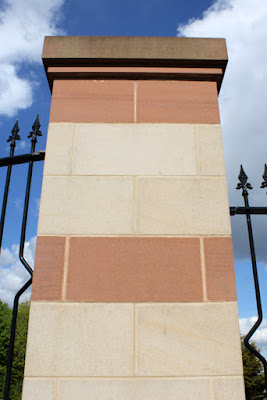 |
| A display of stones on the forecourt of Natural Granite |
Leaving Grimesthorpe Board School, I continued up Grimesthorpe Road until I came across the Sheffield Grand Mosque, where the masonry in the boundary wall looks pristine, although the building was completed a few years ago.
The bright red sandstone looks like Locharbriggs sandstone from Dumfries in the south of Scotland, with its distinctive dark streaks that frequently occur along the bedding. This early Permian sandstone is fluvial, lacustrine and marine in origin, with the deposits laid down in an arid environment that is dominated by hot deserts.
The Marshalls Group owns the Locharbriggs quarry and I suspect that the buff gritty sandstone, which alternates with it in the piers, is one of the Derbyshire gritstones that they also supply – including Stoke Hall and Stanton Moor, both of which are quite similar in colour and texture.
This part of Sheffield is dominated by industries that traditionally grew alongside the steel and heavy engineering works along the Don Valley in Brightside, with the upper slopes to the north side being developed with housing.
When planning my walk, I didn’t see any listed buildings or other points of interest worth investigating between Grimesthorpe and Brightside, so I just dropped down to Petre Street and continued my walk at a brisk pace - noting the high ground formed by the ridge of Parkgate Rock.
Having walked for several hundred metres past miscellaneous businesses that occupy the various industrial units, I came across Natural Granite, a supplier of work surfaces in Sheffield and the surrounding area.
Their painted brick premises are not particularly inviting, but the gate piers and the front wall caught my eye, with a variety of polished grey granites from their stock of 75 granites being used in their construction.
Although I included a selection of granites in the now dismantled Triton Stone Library, which have been used in historic buildings and were still available in the UK 25 years ago, the identification and matching of granites is a very specialist field.
Nevertheless, I was very curious about the various stones laid out on the forecourt and introducing myself to the receptionist, I asked if I could take a couple of photos – where I had identified Baltic Brown, the Blue Pearl and Emerald Pearl varieties of larvikite and other granites from Spain and Sardinia, as well as artificial quartz aggregates such as Silestone.
 |
| A display on the forecourt of Natural Granite |








No comments:
Post a Comment